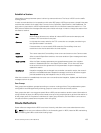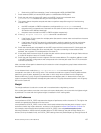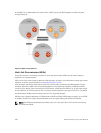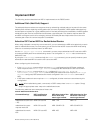
c. Paths with no MED are treated as “worst” and assigned a MED of 4294967295.
7. Prefer external (EBGP) to internal (IBGP) paths or confederation EBGP paths.
8. Prefer the path with the lowest IGP metric to the BGP if next-hop is selected when
synchronization is disabled and only an internal path remains.
9. The system deems the paths as equal and does not perform steps 9 through 11, if the following
criteria is met:
a. the IBGP multipath or EBGP multipath are configured (the maximum-path command).
b. the paths being compared were received from the same AS with the same number of ASs in the
AS Path but with different NextHops.
c. the paths were received from IBGP or EBGP neighbor respectively.
10. If the bgp bestpath router-id ignore command is enabled and:
a. if the Router-ID is the same for multiple paths (because the routes were received from the same
route) skip this step.
b. if the Router-ID is NOT the same for multiple paths, prefer the path that was first received as
the Best Path. The path selection algorithm returns without performing any of the checks
detailed here.
11. Prefer the external path originated from the BGP router with the lowest router ID. If both paths are
external, prefer the oldest path (first received path). For paths containing a route reflector (RR)
attribute, the originator ID is substituted for the router ID.
12. If two paths have the same router ID, prefer the path with the lowest cluster ID length. Paths without
a cluster ID length are set to a 0 cluster ID length.
13. Prefer the path originated from the neighbor with the lowest address. (The neighbor address is used
in the BGP neighbor configuration and corresponds to the remote peer used in the TCP connection
with the local router.)
After a number of best paths is determined, this selection criteria is applied to group’s best to determine
the ultimate best path.
In non-deterministic mode (the bgp non-deterministic-med command is applied), paths are
compared in the order in which they arrive. This method can lead to the system choosing different best
paths from a set of paths, depending on the order in which they were received from the neighbors
because MED may or may not get compared between the adjacent paths. In deterministic mode, the
system compares MED between the adjacent paths within an AS group because all paths in the AS group
are from the same AS.
Weight
The weight attribute is local to the router and is not advertised to neighboring routers.
If the router learns about more than one route to the same destination, the route with the highest weight
is preferred. The route with the highest weight is installed in the IP routing table.
Local Preference
Local preference (LOCAL_PREF) represents the degree of preference within the entire AS. The higher the
number, the greater the preference for the route.
Local preference (LOCAL_PREF) is one of the criteria used to determine the best path, so keep in mind
that other criteria may impact selection, as shown in the illustration in Best Path Selection Criteria. For
this example, assume that thelocal preference (LOCAL_PREF) is the only attribute applied. In the
following illustration, AS100 has two possible paths to AS 200. Although the path through Router A is
shorter (one hop instead of two), the LOCAL_PREF settings have the preferred path go through Router B
Border Gateway Protocol IPv4 (BGPv4)
157


















